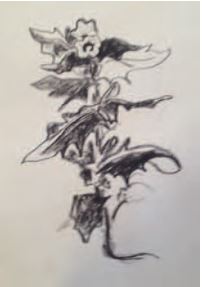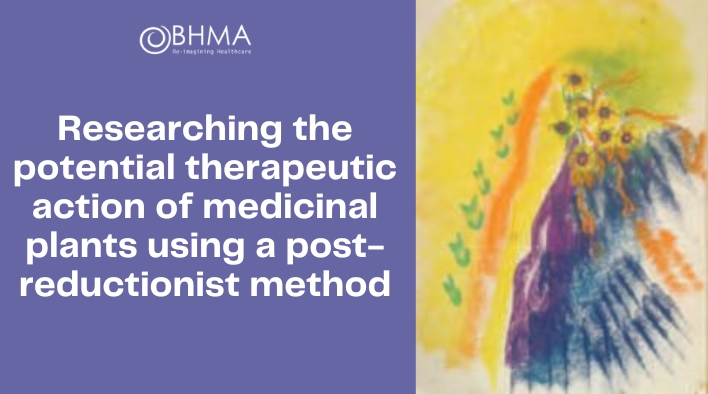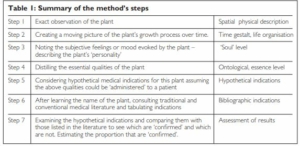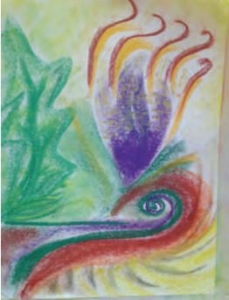Researching the potential therapeutic action of medicinal plants using a post-reductionist method
Michael Evans, Retired GP; postgraduate trainer in anthroposophic medicine in the UK and the Philippines
Published in JHH16.1 – Nature Connections
After studying medicine at the University of Bristol and psychiatry at the Middlesex Hospital, I spent four years exploring a medical approach aiming to encompass patients’ soul and spirit as well as their bodily conditions, in anthroposophic hospitals in Germany and Switzerland. I returned to the UK to help found a residential anthroposophic therapy centre called Park Attwood Clinic. Later I enjoyed applying this approach to the range of problems encountered in NHS general practice in Stroud, Gloucestershire, working with like-minded GPs, therapists and counsellors. I have a special interest in facilitating experiential learning, helping colleagues in the UK, the Philippines and China discover the spirit in themselves and in nature.
Introduction
A future science beyond the reductionist world view will need to explore appropriate ways of consciously including the subjective experience of the researcher alongside more objective observations. The method described here could be a contribution to balancing ‘the over – emphasis on quantity at the expense of quality and the exclusion of subjectivity’ (Walach, 2018).
While there is extensive literature on the traditional uses of plants in many cultures which may have been based on intuitive knowledge as well as practitioners’ experiences, modern research on medicines and phyto – therapy has been dominated by the isolation of individual chemical compounds which are tested in animal trials and randomised controlled trials on humans.
This article describes a method of medicinal plant study and research which is a pioneering approach to include the observers’ experience and which can complement medicinal knowledge gained by more reductionist conventional scientific methods.
The method used has involved groups of between 6 and 18 participants who generally have neither botanical nor medical knowledge of the plant chosen for study. However, the plants that have been studied have been selected by the process facilitator as being recognised for their medical properties in the literature of several medical traditions. The name of the plant is not divulged to research participants until the penultimate stage of the process.
The research process
Exact observation of the plant
The first formal step in the method is to observe an example of the plant either outside in nature or indoors in a pot. Participants are asked to use their sense of sight and smell. They are encouraged to observe the forms, size and colour of all parts of the plant.
After several minutes of silent observation each participant is asked to share one observation, going around the circle till a fairly complete description has been achieved. In this phenomenological process participants are asked to minimise the use of botanical terms and avoid speculation on the plant’s growth process or their subjective reactions or feelings. This step, called ‘exact observation’, focuses on the spatial expression of the plant at one moment in time. The process of observation can be intensified by making a black and white exact drawing of the parts or whole plant using pencil or charcoal.
The plant’s growth process
 The second step of the process involves building a picture of the plant’s growth process. This is what Goethe called ‘exact sensorial fantasy’ (Colquhoun and Ewald, 1996). This is facilitated by looking to find those parts of the plant which appear youngest and those that emerged earlier. If the plant is viewed in its natural environment it is often possible to find examples at an earlier stage and plants at a later stage of their growth. The aim is to make a moving mental image of the process akin to a time-lapse film. Often various hypo – theses of this process arise, and can be discussed by the group. Sometimes questions remain unanswered. The goal of this process is for participants to ‘get inside’ this growing process. This process is called the ‘picturing the growing’ and is the expression of the plant in time which reveals its life dynamics. This process can be intensified by drawing the growth process or choregraphing a group sculpture of the growth process.
The second step of the process involves building a picture of the plant’s growth process. This is what Goethe called ‘exact sensorial fantasy’ (Colquhoun and Ewald, 1996). This is facilitated by looking to find those parts of the plant which appear youngest and those that emerged earlier. If the plant is viewed in its natural environment it is often possible to find examples at an earlier stage and plants at a later stage of their growth. The aim is to make a moving mental image of the process akin to a time-lapse film. Often various hypo – theses of this process arise, and can be discussed by the group. Sometimes questions remain unanswered. The goal of this process is for participants to ‘get inside’ this growing process. This process is called the ‘picturing the growing’ and is the expression of the plant in time which reveals its life dynamics. This process can be intensified by drawing the growth process or choregraphing a group sculpture of the growth process.
Subjective feelings about the plant
The third step is more subjective. Participants are asked about what feelings or mood the plant evokes. This step could be compared with what in psychodynamic psychotherapy is termed countertransference. The step can be aided by reflecting on the following question: ‘If I imagine this as a person, what kind of personality comes to mind?’ It can be helpful to close one’s eyes to reflect on this. Participants are asked to note their descriptions and then share the results. Although the descriptions are quite individual, often common themes and qualities emerge. This step can be anchored if participants make an artistic expression of the characteristics by making a colour abstract representation of the qualities, mood or personality, using for example, coloured pastels. The instructions are not to draw the plant literally, but to express the qualities they have experienced.
Essential character of the plant
The fourth step is to refine and distil participants’ sense of the special qualities of this plant and to reduce their description to only a couple of words. They remind them[1]selves of the previous step and review their artwork. They are challenged to try to find the most salient and individual characteristics of the particular plant, and also to avoid words such as ‘vital’ which might apply to many, if not all, plants. They may borrow descriptions from other participants if they feel they have captured an essence of the plant better. When ready, participants’ distillations are shared and charted.
Hypothetical therapeutic indications of the plant
The fifth step is to hear these essential qualities read out, to take them seriously and respond to the hypothetical question: If a medicine prepared from this plant could give these qualities to a patient, for which illnesses or conditions might it be therapeutic? Participants work alone preparing a list of theoretical indications for this plant. When ready they are shared and noted. Particular therapeutic themes may emerge and as well as areas of repetition or overlap.
Therapeutic indications of the plant in the literature
Only after this fifth step is the name of the plant revealed. A bibliographic search is then performed to include western herbal literature, conventional pharmacy, eastern herbal literature, homeopathic and anthroposophic literature; the indications found are then listed.
Level of confirmation
The sixth step is to revisit the group’s own hypothetical indications and compare them with the indications found in the bibliography. The number and proportion of hypo[1]thetical indications which are ‘confirmed’ by the literature is noted.
When, as is frequently the case, 60–70% of them are ‘confirmed’, the sense can arise that there is far more validity to this process than participants expected.
Discussion
It may be argued that while the method may arrive at indications that older traditions came to, perhaps through an intuitive sense, it is not validated by conventional evidence. With this in mind an article on a plant which has been studied whose constituents have been pharma – ceutically assessed and included in conventional medicine follows below (on henbane [hyocyamus niger] which is known to contain pharmacologically active constituents such as hyoscine and atropine).
To ensure the research process was original and not influenced by previous knowledge, participants are asked if they know the plant and its uses. It is the author’s experience that doctors rarely recognise the medicinal plants studied. If participants recognise the plant and could be aware of its uses, their observations are only heard after the rest of the group. Their perceptions and any therapeutic ideas are excluded from those listed in the study that follows.
While this method needs to be researched and tested more widely and possibly refined by other facilitators and groups, it does appear to yield results of some validity while engaging a method which goes beyond the accepted methods of current materialistic science. It may therefore offer a modest inspiration to the development of post[1]reductionist medical science. It also has the effect of building a ‘personal relationship’ with medicinal substances which is not the case in the conventional study of pharmacology.
The author has noted that groups practised in the method tend to produce indications that are biblio – graphically confirmed to a greater degree. Conventional science aims to bypass subjectivity, mindful that subjective reactions may say more about the observer that the object being observed. The author acknowledges that subjective reactions reflect both the observer and the observed object or plant. I suspect that this method starting with more objective observation steps and using a group sharing and a ‘distillation’ of initial feelings and sense of ‘personality’, may to some extent over[1]come the one-sidedness of a particular individual’s own subjectivity. I offer this paper for discussion to physicians and scientists interested in developing a science beyond reductionism.
Background to the method
The first four steps of this method can be seen as a reflection of the four levels of consciousness described by Steiner and Wegman in the first chapter of their book Fundamentals of Therapy (Steiner and Wegman, 1925). The first of these steps correspond to the methods of natural science appropriate for the non-living world; then three higher levels of consciousness enable perception of the realms of life phenomena, soul and being or spirit respectively.
Alongside its potential value as a research method, I recommend it as a learning and training method for physicians and other healthcare professionals who want to train in more holistic approaches to medicine, helping them to develop a more holistic approach to nature and medical substances. One participant noted:
As a scientifically minded doctor, I was surprised at how the process brought us to such accurate and specific intuitions regarding the potential medicinal utility of the plant(s). When I saw this repeated again and again throughout the course I learned to trust the process and to be able to follow it myself when encountering new plants.’
Dr Simon van Lieshout, NHS GP
This method is used in the British Postgraduate Training in Anthroposophic Medicine1 and in the International Postgraduate Training in Anthroposophic Medicine in the Philippines2 to explore the potential medicinal properties of individual plants. This training is designed for physicians wishing to explore anthroposophic medicine, a holistic, spiritually based extension of conventional medicine (Evans and Roger, 2017).
Notes
- See www.anthroposophic-drs-traing.org for details of this UK three-year part-time course. The next course, designed primarily but not exclusively for doctors, is planned for October 2019.
- See https://medsektion-goetheanum.org/en/training
References
- Colquhoun M, Ewald A (1996) New eyes for plants. Stroud: Hawthorn Press.
- Evans M, Roger I (2017) Healing for body, soul and spirit – an introduction to anthroposophic medicine. Edinburgh: Floris Books
- Steiner R, Wegman I (1925) Fundamentals of therapy. London: Anthroposophical Publishing.
- Walach H (2018) Science beyond a materialist world view – Galileo Commission Report. Available at: https://www.galileocommission.org/ wp-content/uploads/2018/11/Galileo-Report-Final.pdf (accessed 25 January 2019).
For further information and training in anthroposophic medicine see www.amuk.wildapricot.or
The author wishes to acknowledge the contributions of the late Margaret Colquhoun PhD, Dr Jurgen Schurholz, Ian Wiggle MRPharmS, Dr Geofrey Douch and Dr Frank Mulder whose work, together with the author, contributed to the development of this method of research
Henbane plant study
The following section describes examples of the results of applying the method described above to a plant with recognised medical value by conventional pharmacy as well as complementary medical traditions. This plant has been studied by several groups. Details of the first two steps have been well recorded by a group researching the plants included in the anthroposophic medicine called cardiodoron.** The subsequent steps are recorded from participants in the British postgraduate training in anthro[1]posophic medicine during their summer seminar in 2018
The first step of exact observation results in the following description: the plant has a strong vertical stem of around 20cm height with large, dark green, fleshy leaves in a close spiral. These leaves are symmetrical with several points and indentations on either side of the leaves. The lowest flower sits at the top of this stem at the centre point of up to three forked branches set at around 45 degrees from the vertical arise. Hairs are noted on both the vertical stem and are even more obvious on the side stems. The leaves on the side branches are asymmetrical in their indentations and points. They hang downwards from the slanting side stems. The upper side of the leaves, which are a little darker than their underside, are orientated in the same direction as the ‘terminal’ flowers. At the outermost point of each branch several flowers are visible. They have a foetid smell and below them is a hairy furled stem enclosing numerous flower buds. The flowers have five petals and are bilaterally symmetrical. The petals have purple veins. At their bases they are densely purple. More peripherally their background colour is cream on which the purple veins are visible. Above and more medially on the branch are more withered flowers. Also more medially are green cup-like structures with five points uppermost on their rims. They are quite rigid and upright on the stem. More centrally on the stem these cups are brown and dry but also rigid and upright. Within these brown cups is a green swelling which, if cut open, reveals sticky bright orange seeds. Below the side stem hang pairs of leaves opposite pairs of flowers/calix cups uppermost.
The picture of the growing process (the second step) that the group came to was that in spring after the appearance of simple leaves an upright shoot surrounded by leaves would push upwards with the leaves unfurling, opening and growing in a spiral around this stem. While some of the leaves have serrations, they would be bilaterally symmetrical. Later in the year it was pictured that a terminal flower bud would appear with three buds around it from which side branches would emerge. These side branches would now grow at around 45 degrees from the horizontal. These side branches would appear as tightly coiled spirals that would gradually grow and unfold revealing pairs of not quite symmetrical leaves hanging downwards alternating with flower buds which would open when they were roughly in a horizonal orientation. As the paw-like hairy spiral unfurls the flowers move to face upwards and at the same time begin to wither. Their surrounding calix becomes more prominent, initially green and later drying to brown. After the withered flower has dropped off, a green structure in the centre of this cup grows and becomes more prominent. These rigid cup-like structures have five points on their rims and alternate along the ‘dorsum’ of this semi-horizontal side branch. Below them the pairs of leaves hang down ‘ventrally’. The flowering process and the development of leaves on these side branches accompany each other. So vegetative and the flowering process continue side by side. It was imagined that in autumn the plant would die leaving dried stems with their alternating dry cups looking like a dragon’s back with withered leaves hanging below. The group was uncertain about the dispersal of seeds but imagined pollination by flies attracted to the foetid smell of the flowers and wondered if the seeds might be spread by ants.
These first two steps may include inaccuracies. The aim is for participants to engage an intensity of observational skills and in the second stage to create a living mobile picture of the growth process. I hold the view that these steps give an intense objective connection to the plant forming a sound basis for the more subjective descriptions that follow.
‘Personality’ of the plant: the semi-horizonal orientation of the side branches, the hairy paw-like structure, the stickiness, the smell reminiscent of cat urine, and the ventral arrangement of pairs of leaves mirrored by dorsal pairs of jagged hard cup-like structures all conjured up an animal quality. The pale creamy flowers with purple veins and a deep purple interior with their horizontal rather than upright orientation produced a fascination with both beauty and foreboding. The inner responses of participants were expressed in the following words and phrases; ‘sense of darkness’, ‘devilish, spiny, frightening’, ‘threatening, metabolic connection’, ‘reptilian indifference’, ‘poisonous’, ‘crafty, complex’.
In a previous study of this plant with another group one participant wrote the following verse:
With rhythm and vigour you start to grow
A thrusting, spiralling, branching bow
Etheric forces, surging up
Until a flower forms on top
Slowly then your beauty brings
Purple-yellow deadening
Twisting turning snaking eye
Beneath your beauty secrets lie
Animalic forces form
Seeds in hardened skeleton
Dr Simon van Liehout
After having worked at expressing these qualities artistically participants were asked to distil their sense of the special qualities of this plant into a concentrated description. The distillation was as follows:
- potential malevolence
- paralysing annihilation of soul and spirit
- see me, watch me and decide’
- poison eye
- portal to sub-conscious core.
After being reminded of these essential qualities they were asked to take them seriously and respond to the question: If a medicine prepared from this plant could give these qualities to a patient, for which illnesses or conditions might it be therapeutic? Their response was the following list of conditions:
- abdominal cramps *
- nausea *
- diarrhoea ◊
- emetic ◊
- exocrine secretory problems including corneal and skin dryness*
- epilepsy*
- asthma*
- panic*
- nightmares*
- soul shocks, panic attacks, fears in mid childhood *
- dysfunctional teenagers in search of autonomy*
- addiction, substance abuse, alcoholism and self-harm ◊
- low self-worth, borderline personality disorder ◊
- polluted soul states – depression – (homeopathic like treating like) ◊
- fear of darkness – connection to pineal gland ◊
- truth serum (allopathic) ◊
- stagnation or blockage in CNS ‘carrying energetic imprint of blocked kundalini’ (homeopathic) ◊
- loosing centre (psychologically)*
- bending too much forward or backward and adolescent spinal deformities
* Clearly confirmed in literature
◊ potentially supported by literature
Only after this step was the botanical identity of the plant henbane – hyocyamus niger – revealed to the participants who were asked to search the bibliography and tabulate the indications found in the various medical traditions. The following lists of indications were found and then compared with the groups own hypothetical indications.
Conventional pharmacology
Hyoscine(1,2)
Used to treat:
- crampy abdominal pain
- oesophageal spasms
- renal colic, and bladder spasms
- bloating and the spasm-type pain that can be associated with irritable bowel syndrome and diverticular disease
- motion sickness and nausea
- reduce respiratory secretions at the end of life (exocrine secretory problems?)
- atropine
- uveitis
- bradycardia
- smooth muscle spasm
Western herbal indications(3)
- antispasmotic
- to aid sleep – hypnotic
- analgesia and narcotic
- diuretic – mild
- relax involuntary muscle spasms
- reduce secretions
- tranquiliser
- to prepare eye for surgery – pupil dilation
- treating internal inflammation of eye
- mania ‘asylum conditions’
- Parkinson’s disease
- neuralgia
- local use for rheumatic pains and haemorrhoids
- to break up kidney stones
- erectile dysfunction
- liver pain
- to produce hallucinations – ritual use
- to induce hypnotic states
- to induce sensation of flying
- to induce anaesthesia
Homeopathic indications(4)
- spasms of various kinds
- convulsions
- mania
- loquacity and crude language
- sexual disinhibition
- diarrhoea and involuntary nocturnal evacuations
- coughing
- sleeplessness
- ‘bewildering images’
- overexcitability and restlessness
- disruptive behaviour in hyperactive children
- involuntary tics, twitching and grunting
- delirium tremens
- absences ‘coma vigil’
Anthroposophic medical indications(5)
- somatiform disorders eg heart palpitations, restless legs, insomnia, compulsiveness and hypertensive peaks
- arterial hypertension
- ADHD
- dry cramping cough
- hiccups
- impulsivity in children
- psycho-developmental disorders in adolescents
- muscle cramps
- epilepsy
Locally
- dry vulva and Lichen sclerosis
- pruritis
Red = confirming hypothetical indications
Green = possible relationship to hypothetical indications
Comparing and contrasting the group’s own hypothetical indications with the bibliography it was noteworthy that the group’s indications included all but one or two conventional indications for hyocine and atropine, the two recognised ‘active ingredients’ of hyocyamus niger (henbane). Only one, ‘reduce respiratory secretions at the end of life’ is seen as an exocrine secretory problem
Overall, of the 19 theoretical indications around 10 appeared closely confirmed and another eight more vaguely confirmed and only one (bending too much forward or backward and adolescent spinal deformities) not at all confirmed.
The participants found it remarkable that so many of the hypothetical indications were confirmed despite the process including very subjective steps. They also found it remarkable not only that many traditional indications had been ‘rediscovered’ but also that the literature of conventional pharmacology confirmed many of their own findings.
- BNF under NICE Website Hyoscine Hydrobromide and Atropine Sulfate.
- Wikipedia Website Hyoscine.
- Grieve M, A Modern Herbal Henbane 1931 Johnathan Cape p397.
- Boericke W, Materia Medica Hyocyamus 1927 Boericke & Tafel Inc Philadelphia p336.
- Vademecum of Anthroposophic Medicines 2017 Hyocyamus published by The Association of Anthroposphic Physicians in Germany p358.
** The author wishes to acknowledge the contributions of Cardiodoron Research Group made up of the late Margaret Colquhoun PhD, Dr Jurgen Schurholz, Ian Wiggle, Dr Geofrey Douch and Dr Frank Mulder and the author, which contributed to the development of this method of research. The contents of their unpublished paper provided the material used in the plant descriptions above.









